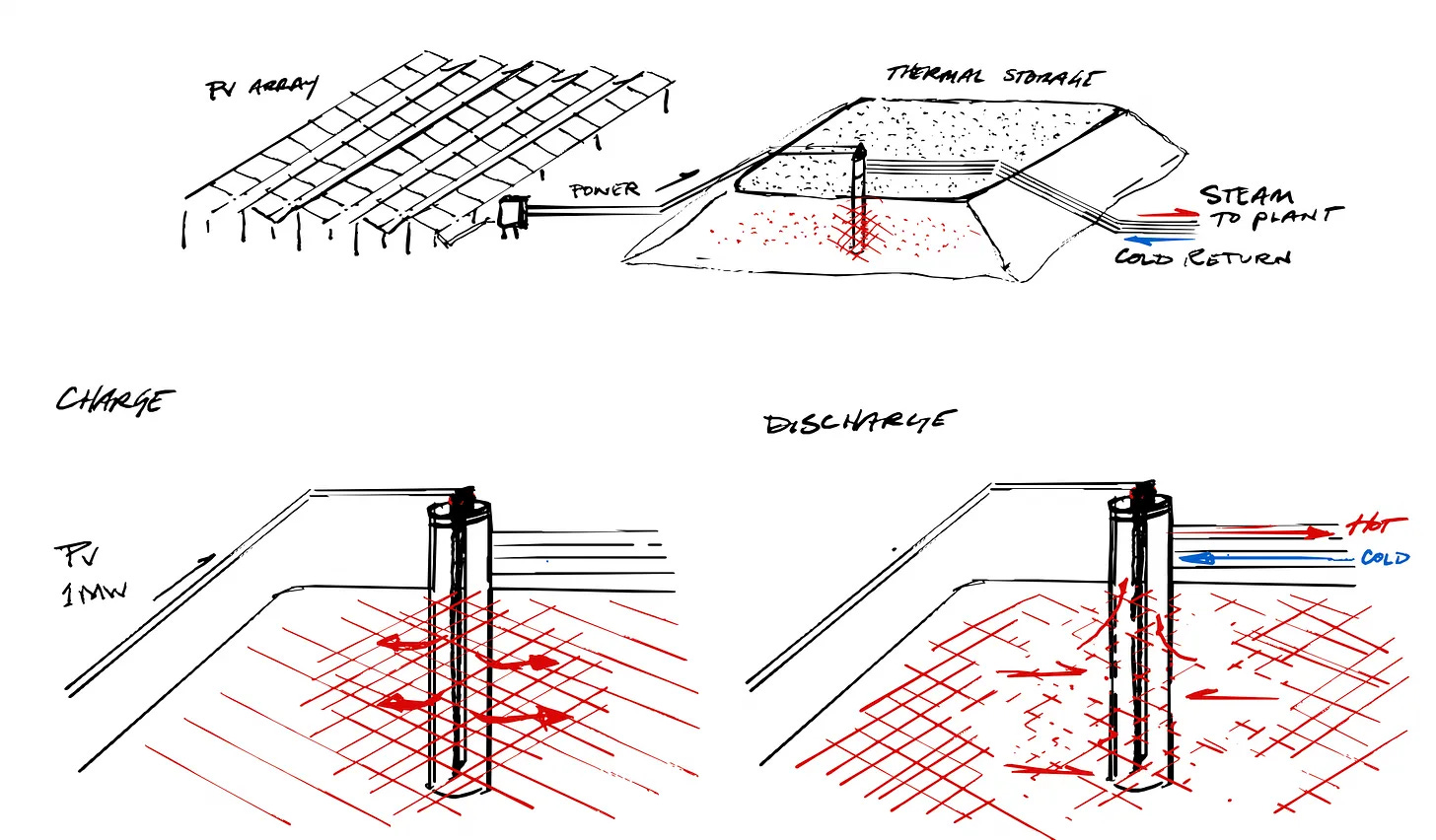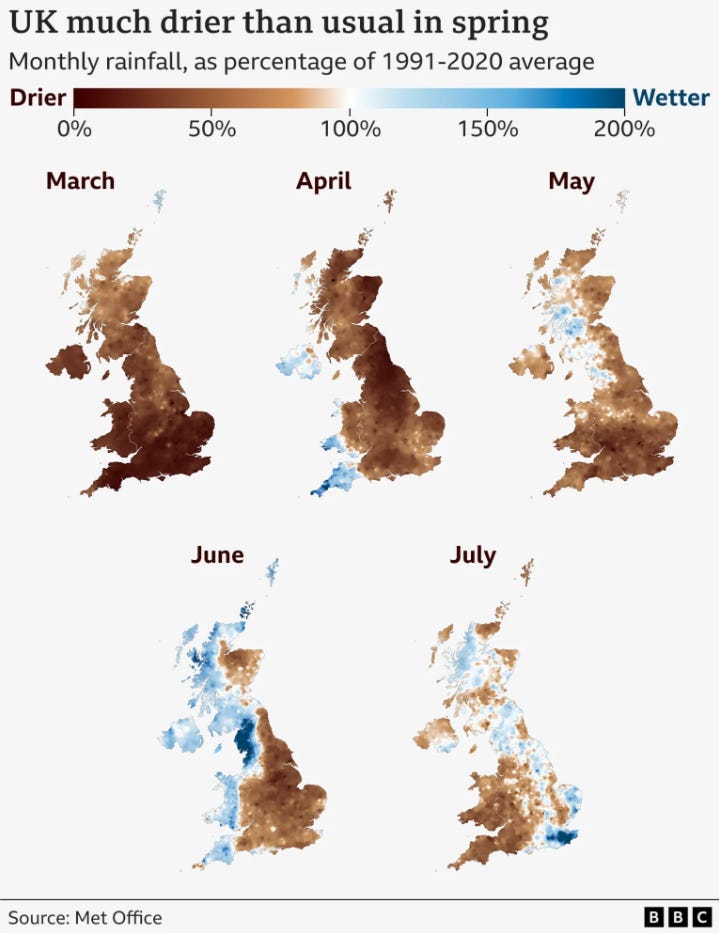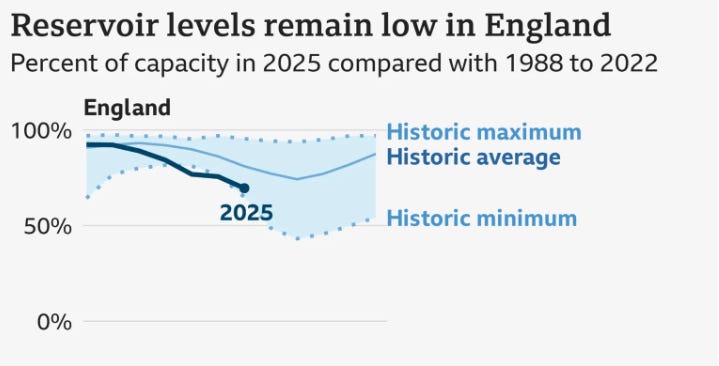Reading List 08/23/25
Thermal energy storage, an adjustable allen wrench, the new race to the moon, the former world’s largest indoor water park, and more.

Welcome to the reading list, a weekly roundup of news and links related to buildings, infrastructure, and industrial technology. This week we look at thermal energy storage, an adjustable allen wrench, the new race to the moon, the former world’s largest indoor water park, and more. Roughly 2/3rds of the reading list is paywalled, so for full access become a paid subscriber.
Standard Thermal
Friend of the newsletter Austin Vernon’s company, Standard Thermal, just emerged from stealth. It aims to achieve extremely low long-term energy storage costs by using electricity from solar PV to heat up huge mounds of dirt. From Austin’s substack:
The purpose of Standard Thermal is to make energy from solar PV available 24/7/365 at a price that is competitive with US natural gas.
Our technology works by storing energy as heat in the least expensive storage material available - large piles of dirt. Co-located solar PV arrays provide energy (as electricity) and are simpler and cheaper than grid-connected solar farms. Electric heating elements embedded in the dirt piles convert electricity to heat. Pipes run through the pile, and fluid flowing through them removes heat to supply the customer. The capital cost, not including the solar PV, is comparable to natural gas storage at less than $0.10/kilowatt-hour thermal and 1000x cheaper than batteries.
These are the customer archetypes we can save the most money for right now:
Solar developers with oversized arrays greater than 300 kilowatts and heat demand at the location. Our system can store the summer excess production for winter thermal demand.
Isolated energy users forced to use propane or fuel oil, typically using more than 50,000 gallons of propane per year.
The storage system can provide hundreds of megawatts of thermal demand as long as land is available…
England drought
England is apparently in the midst of a major drought. Rainfall levels are below average, and reservoir levels have fallen. Many water providers have implemented a ban on using hoses for watering lawns or gardens, and restrictions might get more severe. Via the Guardian:
The National Drought Group met to discuss actions to save water across the country, and Steve Reed, the environment secretary, briefed the chancellor of the duchy of Lancaster, Pat McFadden, about the risks posed by the dry weather.
Water companies are preparing to take more drastic measures to conserve water as supplies dwindle.
Southern Water, some of whose customers are already under a hosepipe ban, has applied for a non-essential use ban that would prohibit businesses from taking actions such as filling swimming pools or cleaning their windows.
The company has also applied for an emergency order to take water from a rare chalk stream after it drops below its ecologically safe water flow.
The drought is hitting many sectors across the country, with many canals shut to navigation due to low water levels, farmers struggling to grow crops and feed livestock, and higher numbers of fish die-offs being reported by anglers and others who use England’s rivers.
Two rivers, the Wye and the Great Ouse at Ely, were at their lowest on record for July, and only 89% of long-term average rainfall was recorded for the month across England. This is the sixth consecutive month of below-average rainfall.
This BBC article has some good graphics illustrating various aspects of the drought:
Reservoir levels are also low:
(I had originally described England as “famously rainy”, but apparently its only ranked number 78 in annual average precipitation. Colombia is #1.)
Related, apparently it’s been 30 years since a new water storage reservoir was built in England.
In an extremely misguided attempt to deal with the water shortage, the UK Government recommended that people delete files off the cloud to reduce load on data centers.
AI environmental impact
On the subject of data center water consumption, earlier this week Google released a paper that analyzes the environmental cost of its “Gemini” AI model. Per Google, the median Gemini response uses 0.24 watt-hours of electricity (equivalent to running a 60-watt lightbulb for about 15 seconds) and 0.26 milliliters of water (about 5 drops).
AI is unlocking scientific breakthroughs, improving healthcare and education, and could add trillions to the global economy. Understanding AI’s footprint is crucial, yet thorough data on the energy and environmental impact of AI inference — the use of a trained AI model to make predictions or generate text or images — has been limited. As more users use AI systems, the importance of inference efficiency rises.
That’s why we’re releasing a technical paper detailing our comprehensive methodology for measuring the energy, emissions, and water impact of Gemini prompts. Using this methodology, we estimate the median Gemini Apps text prompt uses 0.24 watt-hours (Wh) of energy, emits 0.03 grams of carbon dioxide equivalent (gCO2e), and consumes 0.26 milliliters (or about five drops) of water1 — figures that are substantially lower than many public estimates. The per-prompt energy impact is equivalent to watching TV for less than nine seconds.
At the same time, our AI systems are becoming more efficient through research innovations and software and hardware efficiency improvements. For example, over a recent 12 month period, the energy and total carbon footprint of the median Gemini Apps text prompt dropped by 33x and 44x, respectively, all while delivering higher quality responses.
Some folks have criticized this work for only including direct water use, and not including indirect water use required to generate the electricity used. But as we noted in this week’s essay about US water use, the vast majority of water used for electricity generation is non-consumptive, so this wouldn’t have much of an impact on consumptive water use.
Adjustable allen wrench
Chronova Engineering (a YouTube channel we’ve featured before for building the world’s smallest electric motor) has a video showing the construction of an adjustable allen wrench. Adjustable wrenches are of course incredibly common, but this appears to be the first time someone has built an adjustable allen wrench (though it wouldn’t surprise me if prior art exists somewhere).
It turns out that the nature of an allen wrench — which grips a fastener from the inside, and places a large amount of torque along a slender shaft — makes building an adjustable one difficult. The wrench only ends up being adjustable over a relatively short range, 4 mm to 6 mm, and has a fairly bulbous head that prevents access in tight places.
If you’re interested in building one, the 3D files and CAD drawings are available on their (paywalled) Patreon page.





